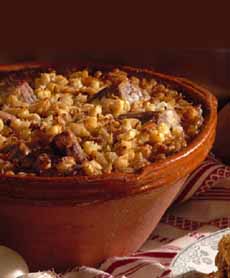TIP OF THE DAY: Cassoulet & Cannellini Beans
|
|
There’s a blizzard covering the East Coast today, turning our thoughts to warm comfort food. How about a cassoulet? If not today, January 9th is National Cassoulet Day (caa-soo-LAY). Cassoulet (cass-oo-LAY, photo #1) originated* in the south of France, a balmy area that doesn’t have to deal with snow. According to French Country Food, the forerunner of modern cassoulet dates to the medieval period. A rustic dish, the stew that simmered for a long time over the fire. Legend has it that during a siege of Castelnaudary, threatened with famine, the townspeople and peasants pooled what they had—bacon, pork, sausages and beans—to make a stew to feed the soldiers defending the city. While many dishes evolve over time, today cassoulet remains a rich, slow-cooked casserole packed full of fatty meats: pork sausages, pork skin (rind), duck or goose, and other meats, such as mutton. Then there are the beans. For the past few centuries this has meant white beans (haricots blancs, or cannellini in Italian, photo #3)—never substitutes. The original beans, however, were broad beans (fava beans). That’s because the genus of beans to which haricots blancs belong is a New World variety. It wasn’t until the 16th century that the beans were brought back to Europe from Mexico and Peru. The Difference Between Cassoulet & Stew The dish was simply another stew recipe until the first commercial production started in Castelnaudary, in 1836 (the town claims to have originated the recipe for cassoulet). But it’s not just any meat-and-vegetable stew. It’s specifically a rich, hearty French stew made with white beans, sausage, pork, and often duck confit. It’s a specific kind of French stew that’s slow-cooked, resulting in a thick, rich consistency. The dish used to slow-cook cassoulet is named after its traditional cooking vessel, a deep, round, earthenware casserole dish with slanting sides—i.e., the cassoulet. The three main towns of the Languedoc† have their own variation on the meats in the recipe. You can find many cassoulet recipes online; here are a few. This Florentine recipe is by Judy Witts Francini of Divina Cucina.com. It was sent to us by Steve Sando of Rancho Gordo New World Specialty Food, one of America’s bean experts and purveyor of the finest artisan beans. You can make a large amount of beans, then portion them and freeze them in plastic freezer bags. Add them to add to soups; use them as a base or side for dinner; or serve as a side with breakfast eggs. Beans are great protein, packed with nutrients. Tip: Spread the roasted garlic cloves on toast. Ingredients 1. PLACE all the ingredients except the salt in the baking dish; cook at 350°F until the beans are tender. Depending on the beans, this can take 1-1/2 to 2 hours. Stir the beans once or twice during the cooking time. The olive oil will create a crust on the top layer of beans. This adds some texture, much like cassoulet. But it can also dry that top layer, which is why you want to stir. 2. SALT the beans at the end of the cooking time, and serve. |
|
|
________________ *Many cuisines have similar recipes, slow-cooking beans and meats in a covered vessel. †Languedoc-Roussillon was a former province in the south of France; its capital city was Toulouse. In January 2016, the former French regions of Languedoc-Roussillon and Midi-Pyrénées were combined into the new region of Occitanie, named after the historical region of Occitania. CHECK OUT WHAT’S HAPPENING ON OUR HOME PAGE, THENIBBLE.COM. |
||







